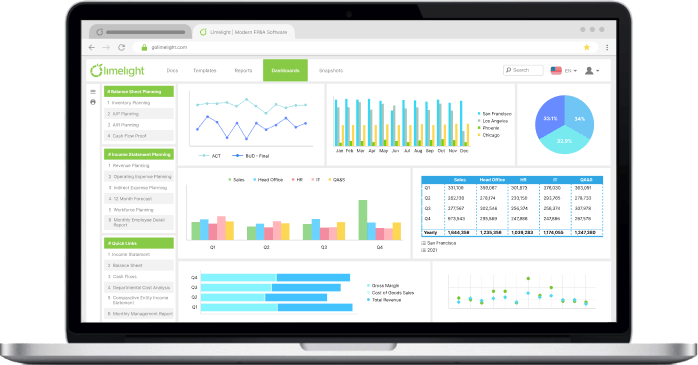If you lead finance, you’ve probably asked yourself some version of these questions:
- How confident are we in our forecasts?
- Do we have the right people in FP&A—or just a bigger team?
- Is our tech stack helping us move faster, or holding us back?
Today, your role extends far beyond closing the books. You’re expected to shape strategy, challenge assumptions, and pressure-test your planning processes—constantly.
That’s where real FP&A statistics in 2025 come in.
Not generic finance trends. Actual benchmarks.
These numbers reveal how other companies are structuring FP&A, how long planning cycles really take, and where modern tech is making a measurable difference.
In this post, we’ve gathered over 50 data points to give you a clear picture of what’s working, what’s changing—and whether you’re adopting FP&A best practices.
Let’s get into it.
50+ FP&A Statistics Every CFO Should Know in 2025
Let’s get down to business. These are some of the most compelling financial planning statistics, backed by credible reports and research papers.
I. CFO leadership and strategic priorities
The Chief Financial Officer (CFO) role is more strategic than ever. But how are today’s finance leaders actually spending their time? These stats reflect what’s top of mind for CFOs in 2025:
- External professional consulting support and fees (40%) and vendor or supplier costs (37%) are the top areas cited by CFOs for potential cost cutting—challenging FP&A teams to do more with less. (Grant Thorton, 2024)
- Fifty-eight percent of CFOs say they dedicate time to financial planning and analysis—making it one of their top areas of focus, alongside business performance management and technology investment. (PwC, 2024)
- In the next five years, 93% of CFOs expect to be actively involved with CIOs, directly leading digitization projects (33%) or partnering with CIOs (60%). (KPMG, 2024)
- Eighty-one percent of CFOs believe they’re the primary drivers of business growth. (SAP Concur, 2025)
II. The expanding scope of FP&A
FP&A teams are stepping out of the back office and into the center of strategic planning. Here’s what that expansion looks like in practice:
- Eighty-two percent of CFOs in a global survey of nearly 600 CFOs said their role has significantly expanded over the past five years. (Egon Zehnder, 2024)
- Forty-four percent of CFOs are focusing on self-directed learning. (The CFO Alliance, 2025)
- Enterprise performance management (EPM) tools are used at least quarterly by 71% of FP&A/finance practitioners, signaling deep penetration overall. (AFP, 2025)
- As regulatory pressures and expectations of strategic business partners grow, environmental, social, and governance (ESG) considerations remain a priority for finance leaders. (Protiviti, 2024)
III. Finance department structures and sizes
Every organization has its own approach to finance staffing and role distribution within the team. Here’s what the data shows:
- On average, a finance leader manages six direct reports. (Gartner, 2024)
- The cost of running a finance function typically averages 1.4% of annual revenue, though best-in-class organizations can reduce this to around 0.7%. (GrowCFO, 2023)
- High-performing digital finance teams dedicate nearly one-third of their staff to technology work. (Gartner, 2024)
- Organizations with centralized finance structures often require fewer full-time equivalent (FTEs) than those with decentralized financial operations. (APQC, 2024)
IV. FP&A career & talent trends
The talent landscape in finance is shifting. The following statistics highlight what’s changing for FP&A roles and which skills are in demand:
- Sixty-six percent of CFOs are exploring mergers or acquisitions to bring in specialized talent and strengthen their companies. (PwC, 2023)
- Among the 68% of FP&A professionals who value their company's upskilling programs, only 17% are considering leaving their roles. (AICPA CIMA, 2025)
- The average tenure for FP&A professionals in top-performing companies is around eight years. (Randstad USA)
- Key skills sought in finance professionals include advanced Excel skills, data analysis and visualization, ERP and FP&A software proficiency, and financial modeling and forecasting. (Finance Alliance, 2024)
V. Common challenges in FP&A
Even as FP&A becomes more strategic and tech-savvy, certain roadblocks are tied to cost pressure, complexity, and stakeholder alignment.
- Over 42% of 35–44-year-old FP&A professionals feel overworked, an early warning sign for retention risks in high-skill roles. (AICPA CIMA, 2025)
- For 46% of FP&A professionals, ensuring financial data consistency and quality remains a top challenge, slowing down insights and eroding stakeholder trust. (FP&A Trends, 2024)
- Over half of FP&A teams use 8+ data categories and 10+ reporting tools quarterly, complicating data consolidation and analysis. (AFP, 2025)
- Sixty-nine percent of finance transformation programs progress slower than expected, with 30% failing to meet goals, often due to poor change management. (Gartner, 2024)
VI. Finance team collaboration and communication
Collaboration between finance and the rest of the business is a must. The following numbers show how often and how well that’s happening:
- Fifty-one percent of CFOs seek to expand engagement in peer groups, recognizing the value of learning from and collaborating with other finance leaders. (The CFO Alliance, 2025)
- Organizations with high CFO-CIO alignment are further along in their digital finance transformation than those without it. (Workday, 2024)
- Only 37% of CFOs say they collaborate seamlessly with their chief sales officer, 35% with the CMO, 34% with the CEO, and 31% with the COO and CHRO. (Workday, 2024)
- Twelve percent of CFOs cite difficulty securing business buy-in as a challenge when implementing new financial technology. (McKinsey, 2024)
VII. Budgeting and planning processes
Many finance teams are still tied to long, manual planning cycles, while others have made big changes. These stats show where organizations fall on that spectrum.
- Tariff-driven price increases of 2.3% in early 2025 are forcing finance teams to adjust pricing or absorb losses—challenging budgets and impacting revenue forecasts. (The Budget Lab by Yale, 2025)
- Fifty-nine percent of finance leaders plan to increase their cybersecurity budget to respond to growing threats. (SAP Concur, 2025)
- Seventy-eight percent of CFOs indicate support for strategy development and increasing commercial analyses as the key areas to be focused on. (KPMG, 2024)
- Sixty-six percent of finance leaders believe Gen AI will have the most immediate impact on explaining forecasting and budgeting variances. (Gartner, 2024)
VIII. Forecasting and financial modeling
Forecasting is one of the clearest indicators of FP&A maturity. These benchmarks cover frequency, accuracy, and modeling methods being used in 2025:
- Up to 85% of top-performing organizations use Centers of Excellence (COEs) to deliver driver-based forecasting. (KPMG, 2022)
- Typical forecast accuracy rates (calculated as 1 minus the error rate) can range from 15% to over 90%, depending on the metric and context. For example, mean absolute percentage error (MAPE) at the product group level can be as low as 3%, whereas forecasts for individual products often exhibit much higher error rates. (Relex, 2023)
- Real-time forecasting is a key trend enabled by cloud-based FP&A platforms and AI-driven analytics, offering instant updates and continuous financial insights to support agile decision-making. (Workday, 2024)
- Fifty-five percent of retail and consumer goods (CPG) finance leaders employ Gen AI for financial forecasting. (Protiviti, 2024)
IX. AI, automation, and predictive analytics in FP&A
CFOs are emerging as tech trendsetters—leading not just financial strategy, but also their organization’s adoption of cutting-edge technologies like AI and automation. Check out these stats:
- More than three in five financial leaders say automation will improve accuracy, provide real-time analytics, and accelerate month-end close. (Controllers Council, 2025)
- Seventy-three percent of CFOs who actively sponsor digital delivery initiatives meet or exceed their targets, compared to just 34% of those who don’t. (Gartner, 2024)
- Twenty-eight percent of finance departments currently use AI in forecasting, with an additional 39% planning to adopt AI-based forecasting within the next 12 months. (PwC, 2024)
- Over the next five years, 85% of finance leaders believe AI and generative AI will create value by generating insights that reduce manual analysis. (McKinsey, 2024)
X. FP&A tools & technology adoption
The tools you use shape how you work. These numbers show which FP&A systems are gaining ground, which ones are outgrowing, and what finance tech stacks look like right now.
- Small companies are projected to have the highest FP&A spending growth rate at 35% between 2024 and 2026. (MGI Research, 2024)
- Almost 100% of FP&A professionals use spreadsheets for monthly planning and reporting. (AFP, 2025)
- The FP&A software market was valued at $3.9 billion in 2023 and is projected to reach $9.7 billion by 2031, growing at a CAGR of 16.4% from 2024 to 2031—highlighting the accelerating adoption of planning and analysis tools across finance functions. (Verified Market Research, 2025)
- Seventy-six percent of finance leaders currently use malware and virus protection as their primary financial security tool. (Controllers Council, 2025)
XI. Financial decision-making and other benchmarks
Business intelligence doesn’t just support decisions—it transforms how they’re made. This section explores how CFOs are using insights to guide strategy, not just report on it.
- Thirty-eight percent of CFOs cite manual processes as a top internal challenge, up from just 1% in 2023. (SAP Concur, 2025)
- Eighty-two percent of companies make decisions based on stale information, and 85% report that this outdated data leads to incorrect decisions and lost revenue. (Business Wire, 2022)
- Seventy percent of CFOs project at least 5% EBITDA growth. (The CFO Alliance, 2025)
- Sixty-one percent of CFOs say inaccurate forecasting is the biggest obstacle to controlling costs. (SAP Concur, 2025)
XII. FP&A trends to watch in 2025
So, what’s next for FP&A? The following statistics show where the function is headed and how jobs could change in the coming months.
- Seventy-seven percent of CFOs and senior finance leaders plan to increase spending on FP&A technology in 2025, with nearly half (47%) expecting to raise it by 10% or more compared to 2024. (Gartner, 2024)
- CFOs are increasingly expected to have a firm grasp of risk management—a skill requirement that appeared in 9% of postings in 2018 and grew to 19% in 2023. (Deloitte, 2024)
- Fifty percent of CFOs plan an organizational restructuring, including changes such as altering reporting lines within their finance teams. (McKinsey, 2023)
- Twenty-three percent of CFOs are exploring a shift into consulting, up from 19% in 2024. (The CFO Alliance, 2025)
- About 65% of CFOs say their organizations are under pressure to accelerate ROI, emphasizing the need for measurable outcomes and strategic alignment. (IBM, 2024)
- The global AI in FP&A market is projected to grow at a CAGR of 34.8% from 2025 to 2034, reaching $4,766.4 million by 2034. (Market.us 2025)
CFO Reflection: What FP&A Statistics Interest You?
There you have it—50+ statistics spotlighting the state of integrated financial planning and analysis. Some may confirm what you already know. Others might make you pause and reassess.
Either way, use these insights as a springboard for team conversations about what needs to change and how to move forward. Finance doesn’t need more opinions—it needs sharper visibility.
That’s where modern FP&A software can make a real difference. Take Limelight, for example. Its Excel-free, cloud-based FP&A platform is purpose-built to help finance teams do more with less—without the limitations of spreadsheets.
From powerful financial modeling and driver-based forecasting to pixel-perfect board reporting and interactive dashboards, Limelight brings together your data, people, and plans in one centralized platform. Automate the manual work. Shorten planning cycles.
Ensure data accuracy. All in a solution that’s flexible enough for complex Opex planning, yet intuitive enough for seamless collaboration.
Even workforce planning—often siloed—becomes a connected, data-driven part of your financial process. Try Limelight Now.
Frequently Asked Questions (FAQs)
1. How is financial planning evolving?
Traditionally, financial planning was a once-a-year exercise: static, reactive, and quickly outdated. But with the world grappling with rapid tech advancements, demographic shifts, and evolving consumer expectations, teams now update forecasts monthly or quarterly. Financial planning is also more cross-functional. The finance team pulls operations, HR, and sales in earlier and more frequently to build models that reflect real business inputs.
2. What are the latest FP&A trends in 2025?
For starters, rolling forecasts are more common at many mid-sized and large companies, replacing fixed annual budgets. There’s growing pressure to reduce cycle times, which means real-time data access is a must.
On the tech side, cloud-based planning tools and AI-powered forecasting have gained strong momentum. AI is being used to improve revenue and demand generation. Many CFOs are also restructuring FP&A to be more integrated with operating teams.
3. How do CFOs use data for financial decision-making?
CFOs use data to compare actuals against plans, evaluate risks earlier, and support scenario planning, significantly minimizing reliance on gut feel and enabling faster course corrections. They give other departmental heads access to real-time financial metrics for shared visibility on budget monitoring, KPI tracking, and problem-solving.
4. What are the key benchmarks for financial planning and analysis?
Some FP&A benchmarks include revenue growth, gross and net profit margins, operating expenses as a percentage of revenue, and EBITDA (earnings before interest, taxes, depreciation, and amortization). In addition, financial performance indicators like working capital turnover and days sales outstanding (DSO) help determine planning effectiveness.






.png?width=381&height=235&name=linkedinreal%20(27).png)
